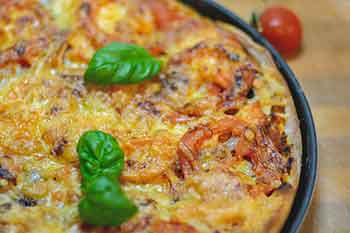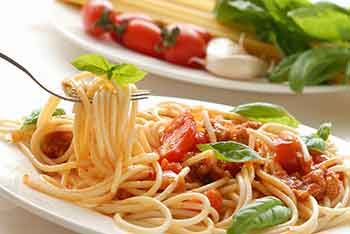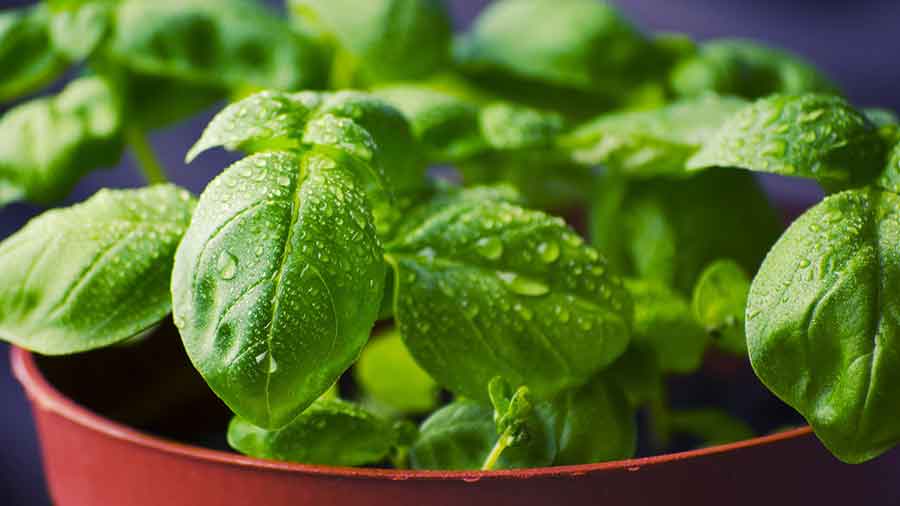I like planting herbs because of their medicinal and culinary uses. I have researched so many things about the basil plant and in this blog, I will share with you all the things I learned.
Basil is a tender, herbaceous plant with alternating broad, light green leaves. Because they come from the mint family, the light green to dark green and purple basil leaves look like peppermint.
There are different varieties of basil. Most common are sweet, Thai, lemon, and holy basil. Known for its distinct aroma, basil contains a variety of essential oils.
Sweet basil has a strong scent like cloves due to eugenol. Lemon basil has a strong citrus scent due to limonene. Fresh leaves taste sweet and peppery. Basil is a cornerstone of the culinary arts, used throughout the world for its fresh flavor. Traditional in a pesto dressing, basil's small leaves have a pungent and delicious flavor. Scatter over any tomato salad, but particularly one with mozzarella cheese.
Basil can be grown in patio pots and grow bags. It makes a great team with tomatoes or in the summer vegetable garden. Pick the leafy shoots, strip off individual leaves, and use them in a wide range of hot and cold dishes.
Basil Grows Best in Warm Weather
Basil seeds should be planted after all dangers of frost have passed. Plant seeds 1/4 inch deep and 12 inches apart. Seeds can be started indoors to get a head start on growing the herb. Plant indoors six weeks before the last frost date and place in a sunny windowsill.
Plant in moist soil that is well-drained. If planting in a container, use a larger pot to prevent plants from drying out in the summer heat.
Basil needs six to eight hours of sun per day. Water the plants freely during dry periods and once flowering begins, pinch off the flower heads to encourage the leaves to continue to grow. Basil does best in soil with a pH of 6 to 7.
Since basil likes moisture, place mulch in the pot or around the plants to help retain moisture. Basil should be pruned once the plant has six to eight leaves. After the basil plant is six weeks old, pinch off the center shoot to keep flowering at bay.
Basil grows well if planted near tomatoes in the garden. The biggest threat to a basil plant is root rot from poor drainage, so ensure the planting site has adequate drainage. Also, watch out for pests such as aphids, slugs, or Japanese beetles.
Basil can Grow on Windowsills too
Basil grows best in full sun and fertile, moist soil. Roots come out about six weeks after seeds have been sown. It can tolerate short periods of drought. It is best grown in hot and dry environments, and can even grow indoors with sufficient sunlight.
Another way to grow it is to buy a pot of supermarket basil, carefully separate out the seedlings, and pot up individually. Keep these in a warm, light spot out of direct sunlight until they are established. Pinch out shoot tips to promote bushiness.
Alternatively, grow from seed on a warm windowsill in spring, prick out and pot on indoors until it is warm enough outdoors to start hardening them off.
Basil is Rich in Vitamins A, C, K, and Manganese
Vitamin A is essential for healthy vision, eyes, skin, and growth. It can also be obtained from beta-carotene, the pigment found in highly colored fruit and vegetables. In addition to acting as a source of vitamin A, beta-carotene has an important role to play as an antioxidant in its own right.
It also acts as an antioxidant, thus helping to protect the cells against cancer
Vitamin K is commonly known as the clotting vitamin but it does more. Recent studies have shown that it helps maintain strong bones by facilitating calcium absorption. Bones end up denser and osteoporosis is prevented or delayed among the elderly. It is also important in keeping the arterial walls flexible to allow blood to pass freely. Vitamin K does this by carrying away calcium that would have attached to the arterial wall lining.
With insufficient vitamin K, the walls of arteries may be damaged and calcified. As an added benefit, vitamin K helps wounds heal faster. The nutrient also helps regulate blood sugar levels.
Vitamin C is essential for growth and vital for the formation of collagen (a protein needed for healthy bones, teeth, gums, blood capillaries, and all connective tissue). It plays an important role in the healing of wounds and fractures and acts as a powerful antioxidant.
Manganese is a vital component of several enzymes that are involved in energy production and many other functions. It is also used to activate enzymes that are integral to the metabolism of glucose and fatty acids. Manganese is needed in making the bones strong and keeping the skin and the immune system healthy.
Basil is best for the Eyes, Heart, and Immune System
Eyes
- Prevents macular degeneration
- Minimizes early onset of cataract
- Keeps eyes moistened
- Filters harmful ultraviolet (UV) rays and keeps them from reaching and damaging the retina
Heart, blood, and blood vessels
- Regulates blood vessel elasticity
- Lowers blood pressure
- Helps prevent platelet clumping, which may result to cardiac arrest
- Lowers triglyceride and cholesterol levels.
Immune System
- Offers antibacterial properties with its volatile oils.
- Prevents bacterial growth
- Helps fight free radical damage on cells
- Prevents cell mutation, which leads to cancerous cell development
- Assists in self-induced cancer cell death
- Prevents cancer cells from spreading
Making a Basil Tea
When you pour boiling or very hot water on fresh or dried parts of a plant and let it soak or steep for a minute or two, you’re generally preparing an herbal tea. When you do this, you get to enjoy the flavor and aroma of the herb and spice in the water you’ll be drinking.

But to get the most benefit out of the plant, you may need to let it steep longer. When you do this, you’re now making an infusion. Infusion is actually caffeine-free.
To make a caffeine-free basil tea or infusion:
Pour 1 cup of boiling water into a cup with 1 tablespoon of dried leaves (double amount for fresh leaves). Add 1 tablespoon of lemon zest. Steep for at least 10 minutes. Strain and serve with honey if desired.
Basil Preparation for Health Care
Basil can be used for the following health conditions:
Headache
Pour a cup of boiling water into a cup with at least 3 sliced basil leaves. Cover and steep for about 10 minutes. Drink twice daily.
Sore throat
Boil 1 cup of water with 8 basil leaves for at least 10 minutes. Add a little salt. Let cool before drinking.
Acne
Boil 1 cup of water and 8 basil leaves for 5 minutes. Cool, strain, and apply the mixture on the affected area using cotton. Leave on for a few minutes before rinsing.
Stress
Boil a cup of water. Add 2 tablespoons of coarsely chopped basil. Remove from fire and steep for 8-10 minutes. Cool then strain.
Bad breath
Chew basil leaves
Tips and precautions
- Harvest basil before the white flowers appear to ensure the sweet taste of leaves.
- Do not wash basil leaves if they are intended to be kept in the refrigerator. Wash leaves only when they are ready to be used
- Dried basil leaves have less essential oils, vitamin C, and beta-carotene
- To prevent bitterness and maintain the flavor, add fresh basil when the dish is almost cooked.
- Its flavor goes well with lemon, olive oil, tomato, and garlic
- Basil has been known to have anti-fertility effects
- Large amounts of basil (as food supplement) may interact with cholesterol-lowering and diabetic medications
- The shelf life of dried basil is 6 months when placed in a tightly sealed glass container. Store in a cool, dark place
- Basil oils and extracts might slow blood clotting and increase bleeding
Ways to prepare

- Added to sautéed vegetables, meat, and fish
- Mixed with dips and salad dressings
- Juiced
- Turned into herbal tea
- Important ingredient in pesto and marinara tomato sauce
- Added to pizzas and pasta dishes
- Added to soups
Basil Recipes
Basil can grow so fast, especially if it receives 6-8 hours of sunlight. With all the basil you can have, what can you use it for? I have researched some recipes requiring basil and these are what I found.
Herby Muffins
3 cups flour
½ cup butter, melted
1 teaspoon basil
1 teaspoon dried oregano
1 tablespoon parsley, chopped
1 cup cheddar cheese, grated
2 eggs lightly beaten
1 ½ cup milk
Mix flour and butter. Add herbs and cheese and stir. Whisk eggs and milk together, add to flour mixture, and mix. Drop heaped tablespoons of coarse and lumpy mixture into well-greased muffin trays. Bake at 400 degrees F for about 20 minutes
Basil Pesto Sauce
A little home-made pesto sauce goes a long way as it is packed with flavor. Toss this sauce into piping-hot pasta just before eating. Store any leftover pesto in a screwtop jar in the fridge (cover the surface of the pesto with a little extra oil).
Makes 150 ml (5 fl oz), to serve 4
2 garlic cloves
30 g (1 oz) pine nuts
30 g (1 oz) Parmesan cheese, freshly grated
20 g (3/4 oz) fresh basil sprigs
5 tbsp extra virgin olive oil
Preparation time: 10 minutes
- Place the peeled garlic in a food processor or herb chopper. Add the pine nuts and Parmesan, and process until the ingredients are finely chopped and thoroughly combined.
- Add the basil, including all the soft stalks. (if the basil is picked from a mature plant with tough stalks, discard these before weighing the sprigs.) Process until the basil is chopped and the mixture begins to clump together.
- Add the olive oil and process until combined. The sauce should have a fine, slightly grainy texture.
Watermelon-Basil Smoothie
1 small watermelon, chunked
6 basil leaves
1 tbsp lemon juice
Crushed ice
Blend everything together on low until well-mixed. Then blend again on high setting for about 10 seconds. Serve immediately.
Spaghetti with Brie and Cherry Tomatoes

Here is a colorful pasta dish full of fresh summery flavors. The asparagus and tomatoes are very lightly cooked before tossing with the hot pasta and cubes of Brie-the tomatoes gently burst and release their sweet juices, and the heat makes the cheese just start to melt.
Serves 4
400 g (14 oz) spaghetti
2 tbsp extra virgin olive oil
2 plump garlic cloves, finely chopped
170 g (6 oz) thin asparagus, cut into 5 cm (2 in) pieces
300 g (10 ½ oz) cherry tomatoes, halved
Large handful of fresh basil leaves, roughly torn
170 g (6 oz) Brie cheese, cut into cubes
Salt and pepper
Preparation and cooking time: 30 minutes
- Cook the pasta in a large pan of boiling water for 10-12 minutes, or according to the packet instructions, until al dente
- Meanwhile, heat the oil in a large frying pan, add the garlic, and cook for about 30 seconds. Don’t let it brown. Tip in the asparagus and add 4 tbsp of water. Cook over a moderate heat for 3-5 minutes, stirring frequently, until the asparagus is just tender and most of the water has evaporated
- Add the cherry tomatoes and basil, and cook for a further 2 minutes or until the tomatoes start to soften but still hold their shape. Season with salt and pepper to taste
- Drain the pasta in a colander, then pour it into a large serving bowl. Add the vegetable mixture and the Brie, and toss gently to mix. Serve hot, sprinkled with a grinding of pepper.
Some more ideas
Make rigatoni with mozzarella and rocket arugula. Replace the spaghetti with rigatoni (or penne), and the Brie with 150 g (5 ½ oz) mozzarella. Omit the asparagus and water, and increase the quantity of tomatoes to 500g ( 1lb 2 oz). In step 4 add 100 g (3 ½ oz) rocket with the mozzarella, tossing with the pasta just until the leaves wilt and the cheese begins to melt.
References
Hendy, Jenny. 2011. Kid’s First Gardening Book. Lorenz Books, Anness Publishing Ltd
Reader’s Digest. Eat Yourself Healthy. Reader’s Digest Association Limited
Villaflor-Almocera, Evelyn. 2017. Healthy Foods Healthy Lives. Philippines: Philippine Publishing House
Gealone-Corpus, Arlene May. 2018. Healthy Herbs and Spices. Philippines: Philippine Publishing House









